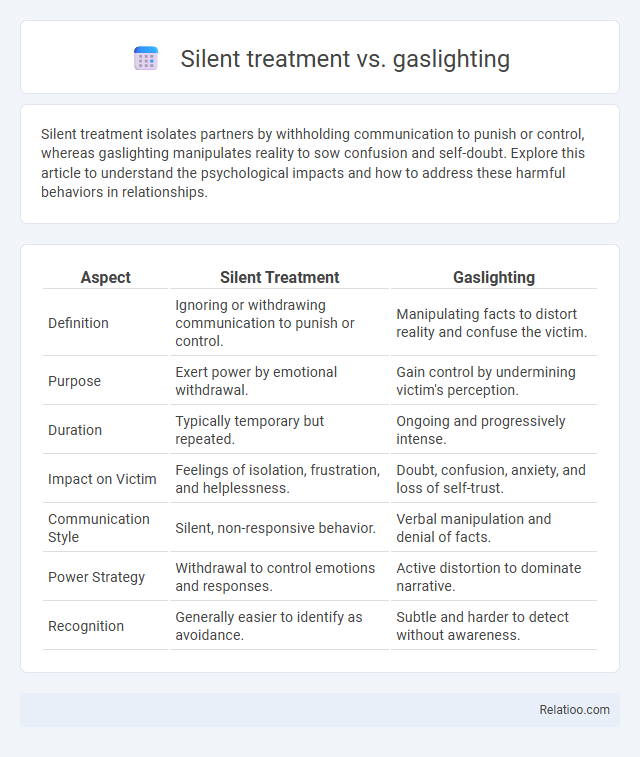Silent treatment isolates partners by withholding communication to punish or control, whereas gaslighting manipulates reality to sow confusion and self-doubt. Explore this article to understand the psychological impacts and how to address these harmful behaviors in relationships.
Table of Comparison
| Aspect | Silent Treatment | Gaslighting |
|---|---|---|
| Definition | Ignoring or withdrawing communication to punish or control. | Manipulating facts to distort reality and confuse the victim. |
| Purpose | Exert power by emotional withdrawal. | Gain control by undermining victim's perception. |
| Duration | Typically temporary but repeated. | Ongoing and progressively intense. |
| Impact on Victim | Feelings of isolation, frustration, and helplessness. | Doubt, confusion, anxiety, and loss of self-trust. |
| Communication Style | Silent, non-responsive behavior. | Verbal manipulation and denial of facts. |
| Power Strategy | Withdrawal to control emotions and responses. | Active distortion to dominate narrative. |
| Recognition | Generally easier to identify as avoidance. | Subtle and harder to detect without awareness. |
Understanding the Silent Treatment
The silent treatment is a passive-aggressive communication tactic used to express displeasure or control a situation by deliberately ignoring someone, creating emotional distance and confusion. Unlike gaslighting, which manipulates reality to make you doubt your perceptions, the silent treatment centers on withholding communication to punish or exert power. Recognizing the silent treatment helps you identify unhealthy relationship dynamics and establish boundaries to protect your emotional well-being.
What is Gaslighting?
Gaslighting is a form of psychological manipulation where one person systematically distorts reality to make another doubt their perceptions, memory, or sanity. Unlike the silent treatment, which involves emotional withdrawal or refusal to communicate, gaslighting actively erodes Your trust in your own mind by denying facts, lying, and planting false information. Recognizing gaslighting is crucial for protecting Your mental health and establishing clear boundaries in toxic relationships.
Key Differences Between Silent Treatment and Gaslighting
Silent treatment involves deliberately ignoring or refusing to communicate as a form of punishment or control, while gaslighting is a manipulative tactic aimed at making someone doubt their perceptions or reality. Key differences lie in intent and impact: silent treatment isolates and withholds emotional connection without distorting facts, whereas gaslighting actively twists truth to undermine self-confidence and sanity. Silent treatment is passive-aggressive avoidance, gaslighting is psychological manipulation designed to confuse and dominate the victim.
Psychological Impact of the Silent Treatment
The psychological impact of the silent treatment includes feelings of isolation, anxiety, and lowered self-esteem, often leading to emotional distress and confusion. Unlike gaslighting, which manipulates perception and reality, the silent treatment operates through emotional withdrawal and passive-aggressive behavior, creating a toxic communication barrier. Prolonged exposure to the silent treatment can contribute to chronic stress, undermining mental health and fostering resentment in relationships.
Emotional Effects of Gaslighting
Gaslighting inflicts severe emotional damage by causing victims to doubt their reality and self-worth, leading to increased anxiety, confusion, and depression. Unlike the silent treatment, which isolates through emotional withdrawal, gaslighting manipulates perception, leaving victims bewildered and dependent on the abuser's version of events. Prolonged exposure to gaslighting often results in a diminished sense of identity and chronic psychological distress.
Signs You’re Experiencing Silent Treatment
Signs you're experiencing silent treatment include prolonged periods of intentional ignoring, refusal to communicate, and emotional withdrawal designed to punish or control. Victims often feel confused, isolated, and anxious due to the abrupt absence of responses in conflicts or everyday conversations. Unlike gaslighting, which manipulates reality through denial or distortion, silent treatment primarily involves withholding communication as a passive-aggressive tactic.
Warning Signs of Gaslighting Behavior
Gaslighting behavior often includes persistent denial of your reality, trivializing your feelings, and manipulating facts to make you doubt your perception or memory. Warning signs include the abuser constantly shifting blame, creating confusion, and isolating you from trusted support systems. Recognizing these tactics is essential for safeguarding your mental health and setting boundaries against emotional abuse.
Why People Use Silent Treatment vs Gaslighting
People use silent treatment as a form of emotional control to express displeasure or punish others without direct confrontation, often leaving the recipient feeling ignored and confused. Gaslighting involves deliberate manipulation to make someone doubt their perception, memory, or sanity, aiming to gain power and control by distorting reality. Both tactics harm relationships, but silent treatment focuses on withdrawal and avoidance while gaslighting attacks the victim's sense of reality.
How to Respond to Silent Treatment and Gaslighting
Recognizing the silent treatment and gaslighting as manipulative behaviors allows you to protect your emotional well-being by setting clear boundaries and seeking support from trusted individuals or professionals. Respond calmly by addressing the behavior directly, using assertive communication to express your feelings without escalating conflict. Prioritize your mental health by maintaining self-awareness and distancing yourself from toxic interactions when these patterns persist.
Healing and Recovery from Emotional Manipulation
Healing from emotional manipulation involves recognizing the distinct patterns of silent treatment and gaslighting to regain your emotional autonomy. Silent treatment isolates you by withdrawal of communication, whereas gaslighting distorts your reality, making your recovery dependent on rebuilding trust in your own perceptions. Effective recovery strategies prioritize setting boundaries, seeking support, and engaging in therapy to restore your self-worth and mental well-being.

Infographic: Silent treatment vs Gaslighting
 relatioo.com
relatioo.com